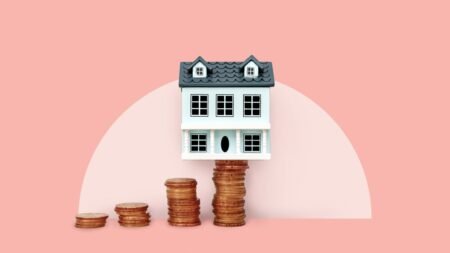Images by GettyImages; Illustration by Hunter Newton/Bankrate
Key takeaways
- The median down payment on a house for a first-time buyer is 9 percent, and some loan programs allow for as little as 3 percent down.
- Making a larger down payment can get you a lower interest rate, but it also means you’ll have less cash for other homebuying expenses.
- A smaller down payment means spending less cash upfront, but also higher monthly mortgage payments and having to pay for private mortgage insurance.
It can be challenging to save money for a down payment on a house, especially if you’re a first-time homebuyer — but you may not have to save as much as you expect. Here’s what to know about the average down payment on a house for a first-time buyer.
Average down payment on a house for first-time homebuyers
Many first-time homebuyers mistakenly believe they must put 20 percent down to qualify for a mortgage. Fortunately, that’s not the case.
9%
The median down payment for first-time homebuyers in 2024.
Source:
National Association of Realtors
The median down payment for a first-time homebuyer was 9 percent in 2024, according to the National Association of Realtors (NAR). For a $400,000 home, a 9 percent down payment totals $36,000.
Compare that to repeat buyers, whose typical down payment in 2024 was 23 percent, or $92,000 on a $400,000 home. Thirty-two percent of first-time buyers reported to NAR that saving for the down payment was the most difficult part of buying a home.
How much should you put down on a house as a first-time buyer?
The amount you should dedicate to a down payment depends on your financial situation, comfort level and other factors.
51%
The percentage of people who say the cost of living is too high to save for a down payment.
Source:
Bankrate 2024 Down Payment survey
If you can put 20 percent down, you’ll avoid mortgage insurance and potentially obtain a lower interest rate, which can save you a lot of money over your loan term. But you shouldn’t do this if it means draining your emergency fund. Plus, you’ll need money for closing costs and expenses like furniture, moving and any home repairs after you move.
Experts also note that it’s typically better to buy a home sooner rather than later. Your savings rate might never match the growth in home prices, so making a down payment of just 3 percent — the minimum down payment with certain first-time buyer programs — might be worth it, even if it means paying mortgage insurance temporarily. Once you have enough equity — usually 20 percent of your home value — you can ask your servicer to get rid of your mortgage insurance.
If you want to know how a specific down payment amount will impact your monthly mortgage costs, try using Bankrate’s mortgage calculator.
Benefits of making a smaller down payment
- Start building equity: You can take possession of a home — and begin building home equity sooner — than if you waited to save more cash.
- Keep more money in your pocket: Moving into a house comes with costs like repairs, remodels and furniture. With a lower down payment, you can keep more of your money to cover these expenses, as well as emergencies not related to your home.
- Get into a home before prices rise further: Saving a 20 percent down payment could take years, and home prices and interest rates could increase further while you’re doing it.
Drawbacks of making a smaller down payment
- Mortgage insurance requirements: Many conventional loan programs require private mortgage insurance (PMI) for homebuyers who put less than 20 percent down. This protects the lender if you default on your mortgage. PMI can cost you an extra $30-$70 per month for every $100,000 borrowed, according to Freddie Mac.
- Less equity: A small down payment means you start out with less equity in the home. If property values drop, you could end up underwater on your mortgage, meaning you owe more than your home is worth. It’ll be a while before you can start borrowing against your equity stake, too.
- A higher interest rate: The more you borrow, the riskier your loan is for your lender. As a result, it’ll charge you a higher mortgage rate.
- Bigger monthly payments: Putting less down upfront means you’ll have a larger loan balance to pay off. That increases your monthly payments.
5 years
The amount of time that nearly one-third of aspiring homeowners (30 percent) say it will take to save enough to buy a home.
Source:
Bankrate 2024 Down Payment survey
How to lower your down payment as a first-time buyer
The lower your down payment, the easier it is to save for it. Here are some methods to lower your down payment:
Low- or no-down-payment mortgages
Several loan programs require a low minimum down payment on a house for a first-time buyer. Here are some of your options:
| Loan type | Down payment minimum | Credit score minimum | Debt-to-income (DTI) ratio maximum |
|---|---|---|---|
| Conventional loan | 3% | 620 | 45% |
| FHA loan | 3.5% | 580* | 50% |
| VA loan | 0% | Usually 620 | 41% |
| USDA loan | 0% | Usually 640 | 41% |
| *can be 500 with a 10% down payment |
First-time homebuyer down payment assistance programs
Many states and local governments offer down payment assistance programs for first-time homebuyers, such as:
- Grants: A grant is essentially a gift that can help cover your down payment and closing costs. You never have to pay it back.
- Forgivable loans: A forgivable loan is a type of second mortgage, typically with a zero-percent interest rate. As its name suggests, you don’t have to repay this loan unless you move, sell or refinance within a certain timeframe.
- Deferred payment loans: Like forgivable loans, a deferred payment loan is a second mortgage that charges little or no interest and helps fund a down payment. However, you’ll need to repay the loan when you move, sell or refinance.
To find out if you’re eligible for down payment assistance, ask your mortgage lender which programs it accepts and whether you qualify.
Other homebuying costs to consider
When you’re deciding how much to devote to your down payment, you’ll also want to factor in other upfront expenses of homeownership. These include:
- Closing costs: Closing costs are the expenses involved in creating and processing your loan, such as the origination, appraisal and title fees. Closing costs range from 2 to 5 percent of a home’s purchase price.
- Cash reserves: Your lender may not require you to provide evidence of cash reserves, especially if you have a strong financial profile — but if it is required, you could need between one month to six months’ worth of mortgage payments in the bank. Even if your lender doesn’t require reserves, it’s still wise to have the savings in case you find yourself unable to pay your mortgage.
FAQ
Read the full article here

















